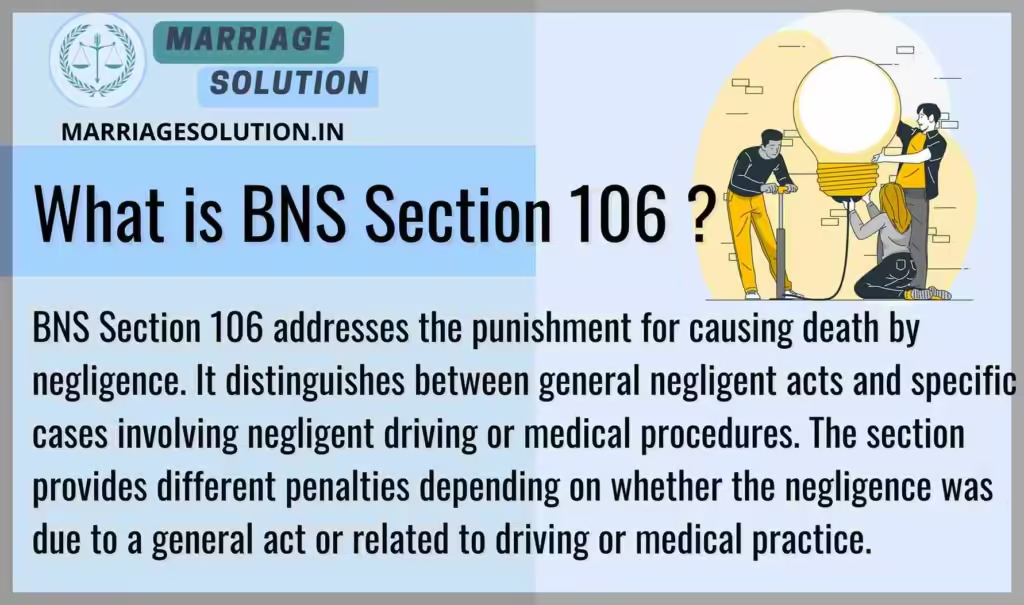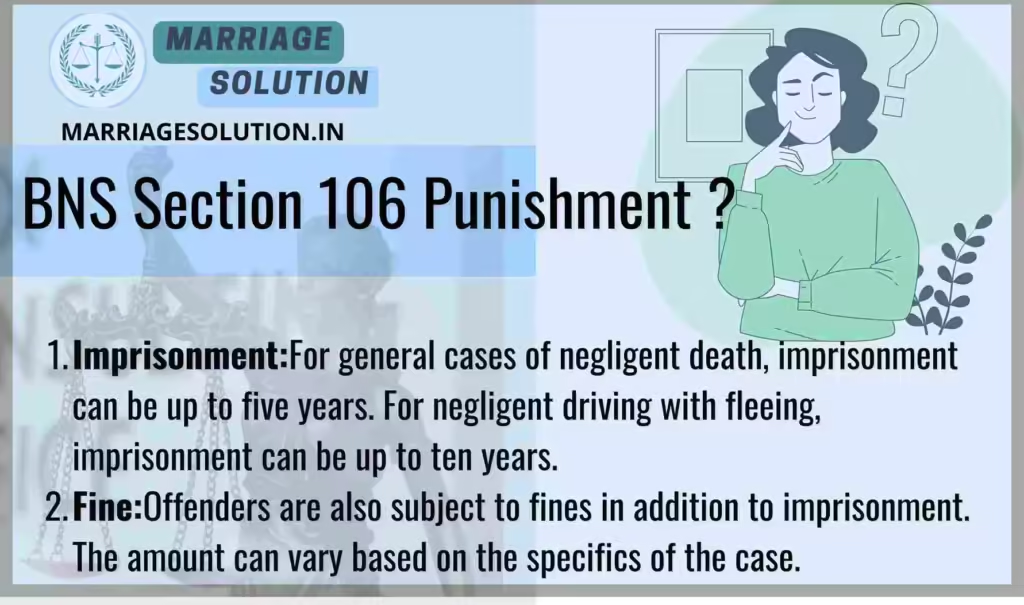Introduction of Section BNS 106
BNS 106 Not every death is intentional. Sometimes, carelessness or negligence leads to loss of life. Section 106 of the Bharatiya Nyaya Sanhita (BNS) addresses such cases—punishing deaths caused by negligence, rash driving, or medical errors. It ensures accountability while distinguishing between different kinds of negligence, prescribing punishments that range from two years for medical negligence to ten years for hit-and-run driving.”
The Bharatiya Nyaya Sanhita (BNS) Section 106 replaces the old Indian Penal Code (IPC) Section 304-A.
- Introduction of Section BNS 106
- What is BNS Section 106 ?
- Bare Act – BNS Section 106
- Explanation in Simple Language
- Key Elements of Section 106
- Section 106 BNS Overview
- BNS 106 Punishment
- BNS 106 bailable or not ?
- Comparison: BNS Section 106 vs IPC Section 304 – A
- Comparison: BNS Section 106 & IPC Section 304
- Need Legal Support?
- Conclusion
What is BNS Section 106 ?
BNS Section 106 addresses the punishment for causing death by negligence. It distinguishes between general negligent acts and specific cases involving negligent driving or medical procedures. The section provides different penalties depending on whether the negligence was due to a general act or related to driving or medical practice.

BNS Act 106 – Causing death by negligence BNS
BNS Section 106 deals with offences where death is caused due to negligence. It introduces broader classifications compared to the old IPC 304A, making special provisions for medical negligence, rash driving, and hit-and-run cases.
(This provision corresponds to the repealed IPC Section 304A and has been restructured under the Bharatiya Nyaya Sanhita (BNS), 2023.)
1. Meaning of Section 106
BNS Section 106 defines liability for causing death by negligence.
- If a person’s careless act, lack of caution, or rash behavior leads to the death of another person, they are held criminally responsible.
- The law distinguishes between general negligence, medical negligence, and negligent driving with escape (hit-and-run).
- This ensures that professionals and individuals are held accountable for preventable deaths caused by their reckless or careless actions.
2. Purpose of Section 106
The purpose of this section is to:
- Ensure accountability for deaths caused by negligence.
- Differentiate between ordinary negligence and specialized cases like medical negligence or hit-and-run accidents.
- Deter professionals and drivers from reckless behavior by imposing stricter punishments.
- Strengthen legal remedies for victims and their families.
3. Essential Ingredients of Section 106
For this section to apply, the following conditions must be satisfied:
- A person must commit a negligent act (failure to take proper care or precautions).
- That negligent act must result in the death of another person.
- The death must not amount to murder (Section 103) or culpable homicide (Section 105).
- The negligence may be:
- General negligence (any individual’s careless act),
- Medical negligence (failure by a doctor or medical practitioner to follow due care), or
- Negligent driving with escape (hit-and-run cases).
4. Punishment under BNS Section 106
The punishment depends on the type of negligence:
- General Negligence → Imprisonment up to 5 years + fine.
- Medical Negligence → Imprisonment up to 2 years + fine.
- Negligent Driving with Escape (Hit-and-Run) → Imprisonment up to 10 years + fine.
The offence may be bailable or non-bailable depending on the specific clause:
- General negligence & medical negligence → Bailable.
- Hit-and-run causing death → Non-bailable.
5. Examples of Section 106 in Action
- General Negligence: A factory supervisor ignores safety rules, leading to a worker’s death in an accident.
- Medical Negligence: A doctor administers the wrong medicine due to carelessness, causing a patient’s death.
- Negligent Driving (Hit-and-Run): A drunk driver kills a pedestrian and escapes the accident site without informing authorities.
6. Importance of Section 106
BNS Section 106 plays a key role in protecting lives by enforcing responsibility in everyday activities:
- It modernizes and strengthens the old IPC 304A.
- It introduces specific punishment for doctors, ensuring patient safety.
- It provides stricter punishment for hit-and-run cases, which were earlier seen as lightly punishable under IPC.
- It serves as a strong deterrent against careless behavior in professional, medical, and public spaces.
By addressing negligence across multiple contexts, this law ensures justice for victims and accountability for offenders.
Section 106 BNS Overview
BNS Section 106 deals with the punishment for causing death through negligence. It specifies different penalties depending on the nature of the negligence, such as general negligent acts, negligent driving, or negligence by medical practitioners. This section outlines how the severity of the punishment can vary based on the type of negligence and the circumstances surrounding the incident.
Section 106 BNS Overview
- Culpable Acts:
- Section 106 deals with deaths caused by negligent acts, not intentional acts of culpable homicide.
- General Negligence Penalty:
- For general cases of negligence causing death, the punishment includes imprisonment for up to five years and a fine.
- Medical Negligence:
- Medical practitioners causing death through negligence while performing procedures can face imprisonment for up to two years and a fine.
- Driving Negligence:
- If a death occurs due to negligent driving and the driver flees the scene, they can be punished with imprisonment for up to ten years and a fine.
- Reporting Requirement:
- If the driver involved in a fatal accident does not report the incident immediately, they face harsher penalties.
- Classification:
- The offences under Section 106 are classified as cognizable, meaning police can arrest without a warrant.
- Bail Status:
- General negligent death cases are bailable, while cases involving fleeing after a driving incident are non-bailable.
- Trial Court:
- Both types of offences under this section are tried by a Magistrate of the first class.
- Compounding:
- These offences are non-compoundable, meaning they cannot be settled through private agreements.
- Severity of Punishment:
- The severity of punishment varies based on whether the negligence was in general actions, medical procedures, or driving incidents, with fleeing drivers facing the harshest penalties.
BNS 106 Punishment
Imprisonment:
- For general cases of negligent death, imprisonment can be up to five years. For negligent driving with fleeing, imprisonment can be up to ten years.
Fine:
- Offenders are also subject to fines in addition to imprisonment. The amount can vary based on the specifics of the case.

BNS 106 bailable or not ?
General Negligence: Bailable
Driving Negligence with Fleeing: Non-Bailable
Comparison: BNS Section 106 vs IPC Section 304 – A
| Points | IPC Section 304A | BNS Section 106 |
|---|---|---|
| Codification | Part of Indian Penal Code, 1860 | Part of Bharatiya Nyaya Sanhita, 2023 |
| Offense Covered | Causing death by negligence (general, including driving, etc.) | Causing death by negligence, with categories → general negligence, medical negligence, and negligent driving with escape |
| Medical Negligence | No separate provision; treated like general negligence | Special provision → Medical practitioner liable up to 2 years + fine |
| Driving Negligence | Rash or negligent driving causing death punishable up to 2 years + fine | Driving causing death with escape (hit-and-run) punishable up to 10 years + fine |
| General Negligence | Imprisonment up to 2 years + fine | Imprisonment up to 5 years + fine |
Comparison: BNS Section 106 & IPC Section 304
| Section | Offense | Punishment | Cognizable? | Bailable? | Compoundable? | By What Court Triable |
|---|---|---|---|---|---|---|
| IPC Section 304 (Old) | Defined culpable homicide not amounting to murder. Same principle: causing death without intention to murder, but with knowledge of likely consequences. |
– If act done with intention: Life imprisonment or up to 10 years + fine. – If act done with knowledge only: Up to 10 years + fine. |
Cognizable | Non-bailable | Non-Compoundable | Court of Session |
| BNS Section 106(1) | Causing death by general negligence. Includes negligence by common persons and medical practitioners. |
– General negligence: Imprisonment up to 5 years + fine. – Negligence by medical practitioner: Imprisonment up to 2 years + fine. |
Cognizable | Bailable | Non-Compoundable | Magistrate of the First Class |
| BNS Section 106(2) | Causing death by rash and negligent driving of a vehicle and escaping without reporting. | Imprisonment up to 10 years + fine. | Cognizable | Non-bailable | Non-Compoundable | Magistrate of the First Class |
BNS Section 106 FAQs
What does Section 106 of BNS cover?
It addresses punishments for causing death through negligent acts, including negligent driving and medical negligence.
What is the BNS 106 punishment for general negligence causing death?
The punishment can be imprisonment for up to five years and a fine.
What is the punishment for a medical practitioner causing death due to negligence?
They can be imprisoned for up to two years and fined.
BNS 106 these offences bailable?
General negligence is bailable, but fleeing drivers are non-bailable.
Need Legal Support?
If you’re facing court proceedings, marriage-related issues, or any legal matter, our team at Marriage Solution – Lawyer Help is ready to guide you. Just complete our easy online enquiry form, and we’ll connect you with the right legal assistance tailored to your needs.
Conclusion
BNS Section 106 ensures that even unintentional deaths caused by negligence are not ignored by law. By prescribing different punishments for general negligence, medical errors, and hit-and-run driving, it balances fairness with accountability. The section protects society by holding individuals responsible for careless acts that cost human lives.
Finished with BNS 106 ? Continue exploring the next provisions of the Bharatiya Nyaya Sanhita (BNS), 2023. Each section includes explanations, examples, and plain-language breakdowns for easy understanding.
- Section 107 BNS : Abetment of suicide of child or person with mental illness .
- https://marriagesolution.in/bns_section/section-107-bns/
- 108 BNS : Abetment of suicide
- https://marriagesolution.in/bns_section/108-bns/
- 109 BNS : Attempt to murder .
- https://marriagesolution.in/bns_section/109-bns/
- 110 BNS : Attempt to commit culpable homicide
- https://marriagesolution.in/bns_section/110-bns/
- Section 111 BNS : Organised crime
- https://marriagesolution.in/bns_section/section-111-bns/
Full IPC Section List: https://marriagesolution.in/ipc-section-list
All Indian Law & Blogs: https://marriagesolution.in/indian-law/
Full BNSS Section List: https://marriagesolution.in/bnss_section-list
